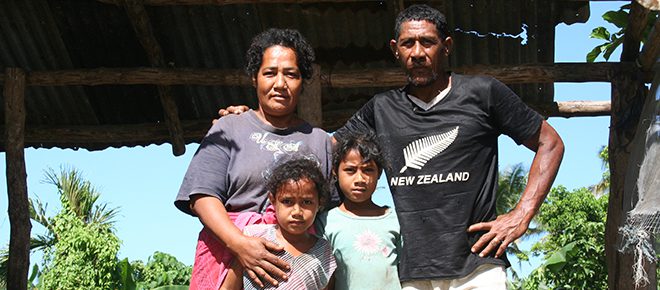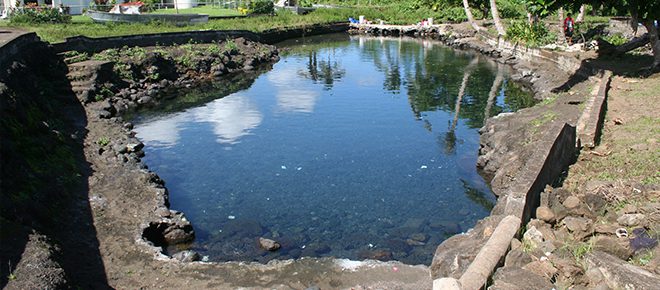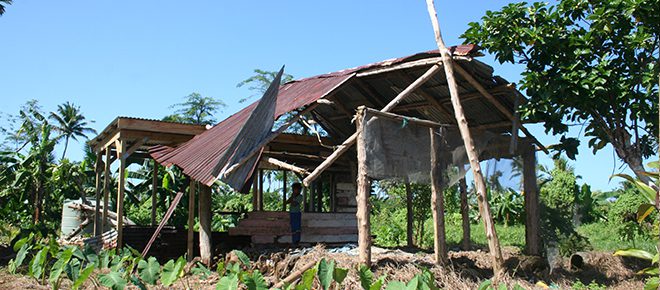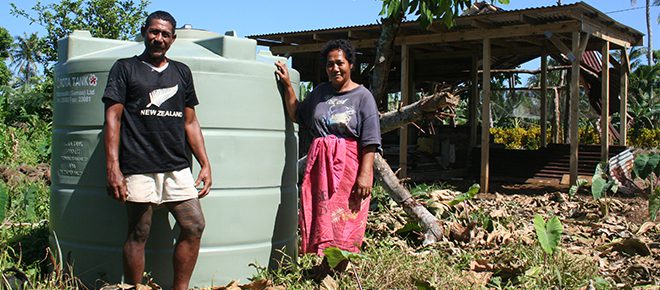Safe water and solid homes: rebuilding after Cyclone Ian and preparing for future shocks

Fata and Faaloala live on a rocky plot of land in the coastal foothills of southern Upolu with their children Faapale, 8, and Merefaea, 10.
Their home is a traditional fale crafted by Fata from bush materials, sheets of corrugated iron and planks of wood, hewn together with rope and old nails. A pit latrine stands out back. The family have few possessions consisting mostly of cooking utensils and gardening tools.
Fata grows all the family’s food — huge leafed taro plants cover his plot, overshadowed by small, sweet misiluki banana trees — and their only income is money from selling surplus fruit and veggies on a roadside stall. Faaloalo spends her time looking after the children and home.
Water needs
 Access to safe drinking water has always been a difficulty. Communities along this stretch of coast are among the last to remain unconnected to the mains water supply.
Access to safe drinking water has always been a difficulty. Communities along this stretch of coast are among the last to remain unconnected to the mains water supply.
Her family used to carry five 20 litre buckets down to the spring along a road that is muddy and rutted, filled with deep puddles and potholes. When it rained, the road become slippery and hard to walk on.
Faaloala said: “We had to get our waterfrom the local spring in the next village. It is five kilometres away and takes me around 40 minutes to walk there. Walking back is much harder. It is uphill and the water is very heavy. All the family travel down together so that we can shower and wash our clothes. And then I carry back drinking water for us.”
In an effort to save time collecting water from the spring, Faaloala captured rainwater that trickled off their rusty fale roof into buckets, plastic containers and anything that came to hand. The stagnant, uncovered water attracted mosquitos and filled with dead insects. Rapid algae growth spurred by Samoa’s tropical climate exposed the family to contaminated water.
Cyclone Evan
Cyclone Evan ripped through Samoa on December 13, 2012, destroying homes and livelihoods. A category three cyclone, it caused extensive destruction, particularly along the South coast communities. Power cuts, uprooted trees and flash floods claimed lives and left homes, farms and businesses ravaged. Fata’s family sheltered in their fale and were left unscathed. But their home was completely destroyed.
Building back: a water and shelter partnership
 Fata and Faaloalo’s priority was to rebuild their family’s home. But they did not have the resources or knowledge on how to build back better.
Fata and Faaloalo’s priority was to rebuild their family’s home. But they did not have the resources or knowledge on how to build back better.
Their limited income meant they could not afford to pay for stronger building materials or the concrete needed to stabilise a dwelling. The only option open to them was using the remains of their old house they could find scattered in the bush.
But the EU stepped in to fund a partnership between Oxfam and ADRA, the Adventist Development and Relief Agency.
Preparing for future shocks
 Through this partnership fales were repaired and strengthened. New cyclone-proof fales were built. The shelters use simple technology to ensure they are enduring and are robust, built from strong wood lashed together with cyclone straps and cemented into the ground.
Through this partnership fales were repaired and strengthened. New cyclone-proof fales were built. The shelters use simple technology to ensure they are enduring and are robust, built from strong wood lashed together with cyclone straps and cemented into the ground.
Oxfam worked with local plumbers to attach rainwater harvesting pipes and tanks to these shelters and built new latrines to enable access to safe water and sanitation. Plastic pipes were attached to the shelters’ tilted corrugated roofs, harvesting rainfall directly into new water tanks located on carefully sized and positioned concrete stands. The concrete ensure the tanks remain stable and do not warp or weaken under the water’s weight.
Fata and Faaloalo’s family had a 3,000 litre tank installed just metres from their property, saving them the hard work of having to trek to the spring or put their health at risk by drinking dirty water.
Faaoloalo said: “I am very pleased we have are having our own water tank, it saves us much work.”
The family are also being provided with a modern pit latrine, replacing the rusty old one that was damaged by Cyclone Evan. The new latrine is a step up from the family’s last one in numerous ways: it has a closing door, a toilet seat, a lid and a latch. The pit itself is also very deep. A local innovation is a pipe system that collects 30 litres of rainwater from the roof of the latrine and feeds it down to a tap stand on the side of the latrine. Now the family can ash their hands immediately after using the toilet.
- Find out more about Oxfam’s sustainable water solutions



